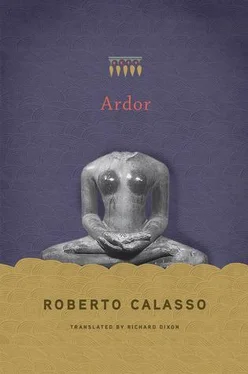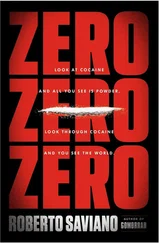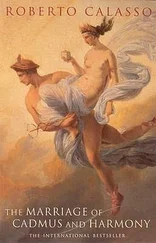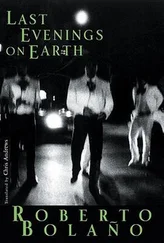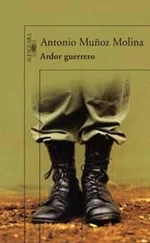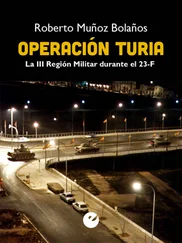* * *
If no one celebrates the rites any longer, if there are no longer any places fit to celebrate them — apart from open countryside, but then the very notion of “open countryside” has become archaic — what is left of the sacrifice? The Vedic ritualists had thought even of this possibility. And their answer: there are still two syllables, svāhā (an invocation, something like “hail!”). “ Svāhā is the sacrifice; thus he makes everything here immediately ready for the sacrifice.” All the differences, ramifications, variations take us back, in the end, to one question: whether or not there is a sacrificial attitude in thought, in action, whether or not the act of making any offering to any invisible presence has meaning. That which indicates the sacrificial attitude, prior to any act, prior to any thought, that which holds it like a sound cell, is a two-syllable invocation: svāhā . The presence or absence of those two syllables shows that action and thought have set off in one or other of the two fundamental directions. That’s why it might be said that “ svāhā is the sacrifice”: that tiny vibration is enough to announce that we have arrived in the world where something will be offered. What is to be offered, and to whom, is in a way secondary to the gesture of that preliminary invocation.
And so it might also be said: “It is only with the offering that a brick becomes whole and complete.” In those words we may find an answer to the question of what is the object of the gesture — an inevitable question, given such a profusion of liturgical gestures. An object — therefore also the object of knowledge — is never just that which is enclosed within a perimeter of matter or within the limits of a definition. To be complete, the object must also include within itself the gesture of the offering — and the entire liturgy is an immense variation on that gesture.
* * *
“The sacrificer being the sacrifice, he thus heals the sacrifice by means of the sacrifice.” Hidden in a sequence of invocations, we find an all-embracing formula, which describes the essence of that action — the sacrifice — which claims that it is everything. In this autistic and tautological vortex, only one word is added: the verb heal. The rest consists of grammatical variations on the word sacrifice. And if the verb heal is the only other word, this already indicates that everything proceeds around a wound, which coincides with life itself.
The sacrifice is a wound. Which has to be healed by inflicting another wound, but in a certain way. And, since wound is added to wound, the wound never closes. And so the sacrifice must be performed over and over again.
* * *
The sacrifice is an interrupted, incomplete suicide (Sylvain Lévi, with his masterly concision: “The only authentic sacrifice would be suicide”). But the ritualists were used to thinking to the extreme. What would happen if, on that journey toward the sky and coming back from the sky, which is the sacrifice, someone refused to come back ? It would be a new rite, the sarvasvāra (the ritualists were relentless classifiers). A rite befitting an old man “who wishes to die.” It will begin with a series of actions and chants that make up the first part of the sacrifice, the part that moves toward the sky. When it is complete, the sacrificer lies down on the ground, with his head covered. Other chants follow. At the end of which the sacrificer must die. But if he doesn’t die? The ritualists also thought of this: “If he remains alive, he shall celebrate the last oblation of the soma sacrifice, after which he will seek to die of hunger.”
And there is yet one more eventuality: what if someone, before reaching old age, wishes to reach the sky through the sacrifice and not come back to earth? The ritualists advised against it: “People say: ‘A life of a hundred years leads to heaven.’ And so one ought not to yield to one’s desires and die before having reached the last term of life, for this does not lead to heaven.” And we know why: the gods don’t like intruders.
* * *
In thought, there is no evolution but rather an occasional concentration, accumulation, crystallization in particular places at particular times. For ousía , it occurred in Greece between the sixth and the fourth centuries B.C.E.; for sacrifice in India, between the tenth and sixth centuries B.C.E.; for hunting in certain tribes, in various parts of the world, we know not when. Each of these peoples was the most tenacious, most lucid, most obsessive in thinking about what is hidden behind those words. Then time served above all to unlearn, to obfuscate these elements of knowledge. But they remained there, waiting to be picked up once again, expanded, worked out, connected.
Sacrifice is a system that can have countless, uncontrollable variants. Always belonging to the same set. More than being a system, it is an attitude: the sacrificial attitude. It is to be found (or not) at every moment in a person’s life. And according to the teachings of the Brāhmaṇas, it is present throughout life, in its perpetual pulsation.
* * *
In the theories of sacrifice, after many twists and turns, we reach a final fork: either sacrifice is a device used by society to ease certain tensions or to satisfy certain needs, in which case it has to be said that it is a ruthless institution based upon a collective illusion that is perpetuated from generation to generation; or it is an attempt by society to blend with nature, taking on certain irreducible characteristics, in which case it must be seen as a form of metaphysics put into action, celebrated and displayed in a formalized sequence of gestures. In the first case, sacrifice would be an official part of society to be rejected without any second thoughts: a society that, in order to sustain itself, needs to choose arbitrary victims, simply because it must kill someone, is a society that no enlightened thinking could put forward as a model. In the second case, sacrifice would be a form of metaphysics to be refused or accepted. And an experimental form of metaphysics, based not just on certain propositions, but on certain acts.
* * *
Rudra is the most powerful objection to the sacrificial world of the Vedas. He accompanies it like a shadow, he watches its disruption. In the Black Age, that patient, noble work of sacrificial builders would no longer be feasible. Rudra, the nameless, was to become the ever-present Śiva, already multiform in his names, ruler over every cult. For only Śiva, as obscure as the primordial archer, the unnameable Rudra, resembles the obscurity of time. Only Śiva can absorb time into himself — time which kills without remedy.
Desire, Kāma, swirls about with his sugarcane bow and his five flower-arrows. The only one who can reduce him to ashes is Śiva. This was the obsessive thought: desire that provokes action, that produces fruits. One of these fruits is the world itself — its enchantment. The one who incinerates desire is therefore the destroyer of the world. But does this mean that Śiva would become an enemy of desire? Such a conflict would be too simple, too crude. On the contrary: Śiva is also the one who, more than anyone else, is susceptible to desire, who continually exasperates it, who pushes it to the extreme, who lets it run in his veins — to the point that sometimes we might think that Śiva is desire, that Śiva is Kāma.
When Brahmā curses Kāma, he incites him to turn on Śiva, because he knows that only Śiva can crush Kāma. In the same way that he knows that only Kāma can wound Śiva. By bringing Kāma and Śiva together, Brahmā knows that in this way he can avenge himself against the one who has subjugated him (Kāma) and the one who has mocked him (Śiva). And he hopes they will torment each other endlessly, like two warring brothers.
Читать дальше
